Clinical Evaluation of Underwater Discharge Plasma as a Root Canal Irrigant: A Randomized Pilot Study on Efficacy and Safety
Abstract
1. Introduction
2. Materials and Methods
2.1. Study Design and Ethical Approval
2.2. Participants
2.3. Randomization and Allocation
2.4. Endodontic Procedures
2.5. Pain Assessment
2.6. Radiographic Assessment
2.7. Statistical Analysis
3. Results
3.1. Pain Assessment Results
3.2. Radiographic Outcomes
3.3. Clinical Success Rates
3.4. Interobserver Agreement
4. Discussion
5. Conclusions
Author Contributions
Funding
Institutional Review Board Statement
Informed Consent Statement
Data Availability Statement
Conflicts of Interest
Abbreviations
| CAPP | Cold atmospheric pressure plasma |
| CHX | Chlorhexidine |
| NaOCl | Sodium hypochlorite |
| NiTi | Nickel–titanium |
| NTPP | Non-thermal atmospheric pressure plasma |
| PAI | Periapical index |
| PAL | Plasma activated liquid |
| RCT | Root canal treatment |
| ROS | Reactive oxygen species |
| TA | Terephthalic acid |
| UDP | Underwater discharge plasma |
| VAS | Visual analog scale |
References
- Siqueira, J.F., Jr.; Rocas, I.N. Clinical implications and microbiology of bacterial persistence after treatment procedures. J. Endod. 2008, 34, 1291–1301. [Google Scholar] [CrossRef] [PubMed]
- Zehnder, M. Root canal irrigants. J. Endod. 2006, 32, 389–398. [Google Scholar] [CrossRef]
- Schafer, E.; Burklein, S. Impact of nickel-titanium instrumentation of the root canal on clinical outcomes: A focused review. Odontology 2012, 100, 130–136. [Google Scholar] [CrossRef]
- Grande, N.M.; Castagnola, R.; Minciacchi, I.; Marigo, L.; Plotino, G. A review of the latest developments in rotary NiTi technology and root canal preparation. Aust. Dent. J. 2023, 68 (Suppl. 1), S24–S38. [Google Scholar] [CrossRef]
- Fridman, G.; Friedman, G.; Gutsol, A.; Shekhter, A.B.; Vasilets, V.N.; Fridman, A. Applied plasma medicine. Plasma Process. Polym. 2008, 5, 503–533. [Google Scholar] [CrossRef]
- Yan, D.; Sherman, J.H.; Keidar, M. Cold atmospheric plasma, a novel promising anti-cancer treatment modality. Oncotarget 2016, 8, 15977–15995. [Google Scholar] [CrossRef]
- Kong, M.G.; Kroesen, G.; Morfill, G.; Nosenko, T.; Shimizu, T.; Van Dijk, J.; Zimmermann, J. Plasma medicine: An introductory review. N. J. Phys. 2009, 11, 115012. [Google Scholar] [CrossRef]
- Reuter, S.; Tresp, H.; Wende, K.; Hammer, M.U.; Winter, J.; Masur, K.; Schmidt-Bleker, A.; Weltmann, K.-D. From RONS to ROS: Tailoring plasma jet treatment of skin cells. IEEE Trans. Plasma Sci. 2012, 40, 2986–2993. [Google Scholar] [CrossRef]
- Jungbauer, G.; Moser, D.; Müller, S.; Pfister, W.; Sculean, A.; Eick, S. The antimicrobial effect of cold atmospheric plasma against dental pathogens—A systematic review of in-vitro studies. Antibiotics 2021, 10, 211. [Google Scholar] [CrossRef] [PubMed]
- Muniz, A.B.; Vegian, M.R.d.C.; Pereira Leite, L.D.; da Silva, D.M.; Moreira Milhan, N.V.; Kostov, K.G.; Koga-Ito, C.Y. Non-thermal atmospheric pressure plasma application in endodontics. Biomedicines 2023, 11, 1401. [Google Scholar] [CrossRef]
- Rupf, S.; Lehmann, A.; Hannig, M.; Schäfer, B.; Schubert, A.; Feldmann, U.; Schindler, A. Killing of adherent oral microbes by a non-thermal atmospheric plasma jet. J. Med. Microbiol. 2010, 59, 206–212. [Google Scholar] [CrossRef]
- Peters, O.A.; Schonenberger, K.; Laib, A. Effects of four Ni-Ti preparation techniques on root canal geometry assessed by micro computed tomography. Int. Endod. J. 2001, 34, 221–230. [Google Scholar] [CrossRef]
- Pereira, R.S.; Rodrigues, V.A.A.; Furtado, W.T.; Gueiros, S.; Pereira, G.S.; Avila-Campos, M.J. Microbial analysis of root canal and periradicular lesion associated to teeth with endodontic failure. Anaerobe 2017, 48, 12–18. [Google Scholar] [CrossRef] [PubMed]
- Karamifar, K.; Tondari, A.; Saghiri, M.A. Endodontic Periapical Lesion: An Overview on the Etiology, Diagnosis and Current Treatment Modalities. Eur. Endod. J. 2020, 5, 54–67. [Google Scholar] [CrossRef]
- Bosch-Aranda, M.L.; Canalda-Sahli, C.; Figueiredo, R.; Gay-Escoda, C. Complications following an accidental sodium hypochlorite extrusion: A report of two cases. J. Clin. Exp. Dent. 2012, 4, e194–e198. [Google Scholar] [CrossRef] [PubMed][Green Version]
- de Sermeno, R.F.; da Silva, L.A.; Herrera, H.; Herrera, H.; Silva, R.A.; Leonardo, M.R. Tissue damage after sodium hypochlorite extrusion during root canal treatment. Oral Surg. Oral Med. Oral Pathol. Oral Radiol. Endod. 2009, 108, e46–e49. [Google Scholar] [CrossRef] [PubMed]
- Xu, H.; Ye, Z.; Zhang, A.; Lin, F.; Fu, J.; Fok, A.S. Effects of concentration of sodium hypochlorite as an endodontic irrigant on the mechanical and structural properties of root dentine: A laboratory study. Int. Endod. J. 2022, 55, 1091–1102. [Google Scholar] [CrossRef]
- Fridman, A. Plasma Chemistry; Cambridge University Press: Cambridge, UK, 2008. [Google Scholar]
- Akiyama, H.; Akiyama, M. Pulsed discharge plasmas in contact with water and their applications. IEEJ Trans. Electr. Electron. Eng. 2021, 16, 6–14. [Google Scholar] [CrossRef]
- Ahmed, M.; Choi, S.; Lyakhov, K.; Shaislamov, U.; Mongre, R.; Jeong, D.; Suresh, R.; Lee, H. High-frequency underwater plasma discharge application in antibacterial activity. Plasma Phys. Rep. 2017, 43, 381–392. [Google Scholar] [CrossRef]
- Muddasir; Qasim, I.; Ahmed, M.W.; Ijaz Khan, M.; Bukhari, H.; Mohamed, M.A.S.; Ibrahim, A.O.; Bashir, F.M.; Eldin, S.M. Degradation of Vibrio cholerae from drinking water by the underwater capillary discharge. Open Phys. 2023, 21, 20220243. [Google Scholar] [CrossRef]
- Mehta, D.; Coleman, A.; Lessani, M. Success and failure of endodontic treatment: Predictability, complications, challenges and maintenance. Br. Dent. J. 2025, 238, 527–535. [Google Scholar] [CrossRef]
- Duncan, H.F.; Galler, K.M.; Tomson, P.L.; Simon, S.; El-Karim, I.; Kundzina, R.; Krastl, G.; Nagendrababu, V.; Dummer, P.M.H. Treatment of pulpal and apical disease: The European Society of Endodontology (ESE) S3-level clinical practice guideline. Int. Endod. J. 2023, 56, 238–295. [Google Scholar] [CrossRef]
- Ørstavik, D.; Kerekes, K.; Eriksen, H.M. The periapical index: A scoring system for radiographic assessment of apical periodontitis. Dent. Traumatol. 1986, 2, 20–34. [Google Scholar] [CrossRef]
- Scholtz, V.; Vaňková, E.; Kašparová, P.; Premanath, R.; Karunasagar, I.; Julák, J. Non-thermal plasma treatment of ESKAPE pathogens: A review. Front. Microbiol. 2021, 12, 737635. [Google Scholar] [CrossRef]
- Qian, J.; Joshi, R.; Kolb, J.; Schoenbach, K.; Dickens, J.; Neuber, A.; Butcher, M.; Cevallos, M.; Krompholz, H.; Schamiloglu, E.; et al. Microbubble-based model analysis of liquid breakdown initiation by a submicrosecond pulse. J. Appl. Phys. 2005, 97, 113304. [Google Scholar] [CrossRef]
- Golpaygani, A.T.; Movahedi, M.; Reza, M. A study on performance and safety tests of electrosurgical equipment. J. Biomed. Phys. Eng. 2016, 6, 175–182. [Google Scholar]
- Fontanezi, B.S.; Bronzato, J.D.; Mohara, N.T.; De-Jesus-Soares, A.; Frozoni, M. Assessment of root surface temperature during the use of an intracanal agitation system: In vitro study. Braz. Dent. J. 2023, 34, 44–53. [Google Scholar] [CrossRef] [PubMed]
- de Hemptinne, F.; Slaus, G.; Vandendael, M.; Jacquet, W.; De Moor, R.J.; Bottenberg, P. In vivo intracanal temperature evolution during endodontic treatment after the injection of room temperature or preheated sodium hypochlorite. J. Endod. 2015, 41, 1112–1115. [Google Scholar] [CrossRef]
- Dotto, M.E.P.; Savaris, J.M.; Dias-Junior, L.C.d.L.; Schmidt, T.F.; Garcia, L.d.F.R.; Teixeira, C.d.S.; Bortoluzzi, E.A.; Manicone, P.F. Real-Time Analysis of Changes in Internal and External Root Temperatures Using Different Systems for Activating the Irrigation Solution. Int. J. Dent. 2025, 2025, 3385512. [Google Scholar] [CrossRef]
- Kim, Y.J.; Hwang, Y.C.; Kim, S.H.; Hwang, I.N.; Choi, B.Y.; Jeong, Y.J.; Juhng, W.N.; Oh, W.M. Analysis of temperature rise on the root surface during continuous wave of condensation technique. J. Korean Acad. Conserv. Dent. 2003, 28, 341–347. [Google Scholar] [CrossRef]
- Kanazawa, S.; Furuki, T.; Nakaji, T.; Akamine, S.; Ichiki, R. Application of chemical dosimetry to hydroxyl radical measurement during underwater discharge. J. Phys. Conf. Ser. 2013, 418, 012102. [Google Scholar] [CrossRef]
- Peng, K.; Tian, S.; Zhang, Y.; He, Q.; Wang, Q. Penetration of hydroxyl radicals in the aqueous phase surrounding a cavitation bubble. Ultrason. Sonochem. 2022, 91, 106235. [Google Scholar] [CrossRef] [PubMed]
- Yasui, K. Production of O radicals from cavitation bubbles under ultrasound. Molecules 2022, 27, 4788. [Google Scholar] [CrossRef] [PubMed]
- Banaszak, A.; Terefinko, D.; Motyka-Pomagruk, A.; Grzebieluch, W.; Wdowiak, J.; Pohl, P.; Sledz, W.; Malicka, B.; Jamroz, P.; Skoskiewicz-Malinowska, K.; et al. Possibilities of Application of Cold Atmospheric Pressure Plasmas in Dentistry—A Narrative Review. Plasma Process. Polym. 2025, 22, 2400246. [Google Scholar] [CrossRef]
- El Shishiny, S.A.; Morad, Y.O.; Hindi, R.I.; El-Motasem, A.M.; El Sheshiny, A.A.; Alramady, D.M.; Samy, A.M. Efficacy of non-thermal pressure plasma versus other modalities for disinfection of primary root canals. BMC Oral. Health 2025, 25, 54. [Google Scholar] [CrossRef] [PubMed]
- Ng, Y.L.; Mann, V.; Rahbaran, S.; Lewsey, J.; Gulabivala, K. Outcome of primary root canal treatment: Systematic review of the literature–Part 2. Influence of clinical factors. Int. Endod. J. 2008, 41, 6–31. [Google Scholar] [CrossRef]
- Ricucci, D.; Langeland, K. Apical limit of root canal instrumentation and obturation, part 2. A histological study. Int. Endod. J. 1998, 31, 394–409. [Google Scholar] [CrossRef]
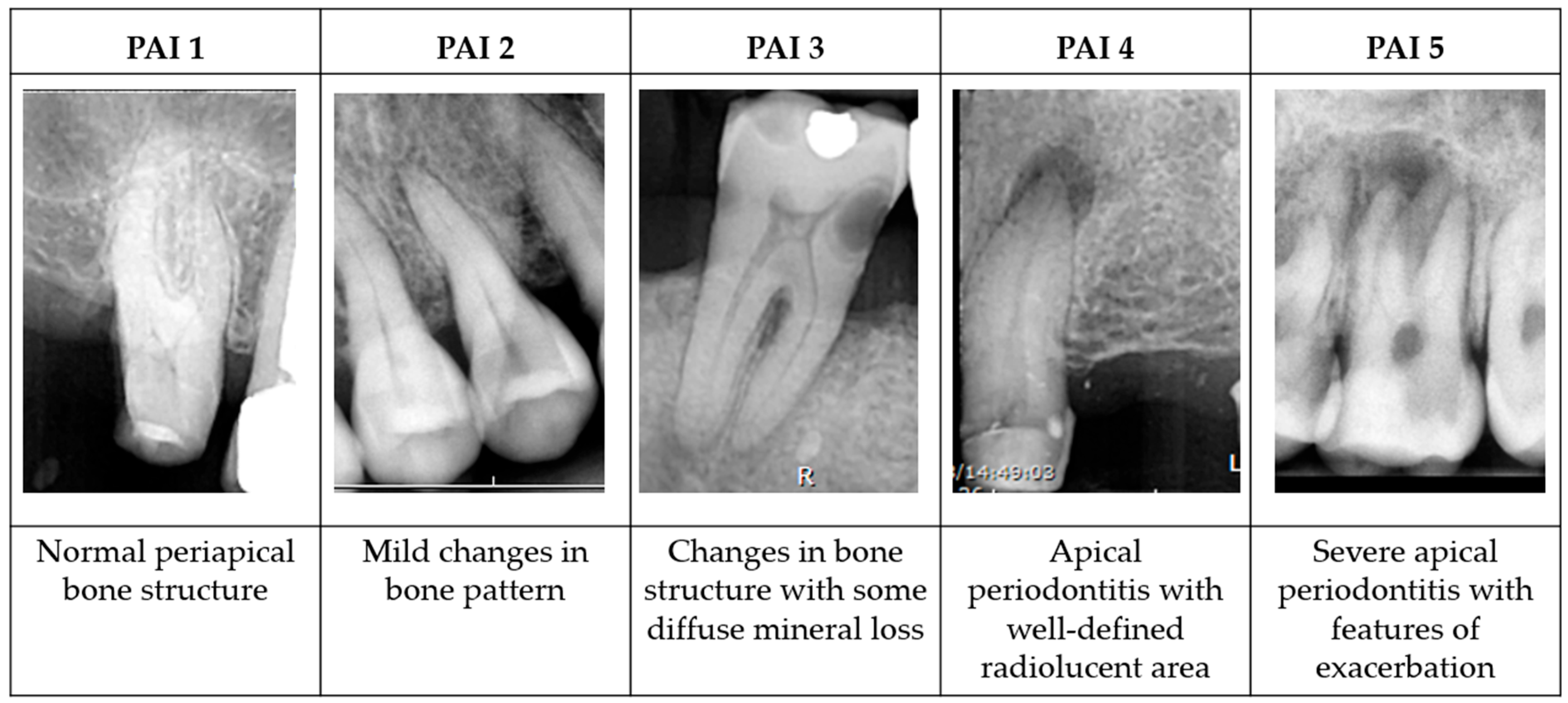
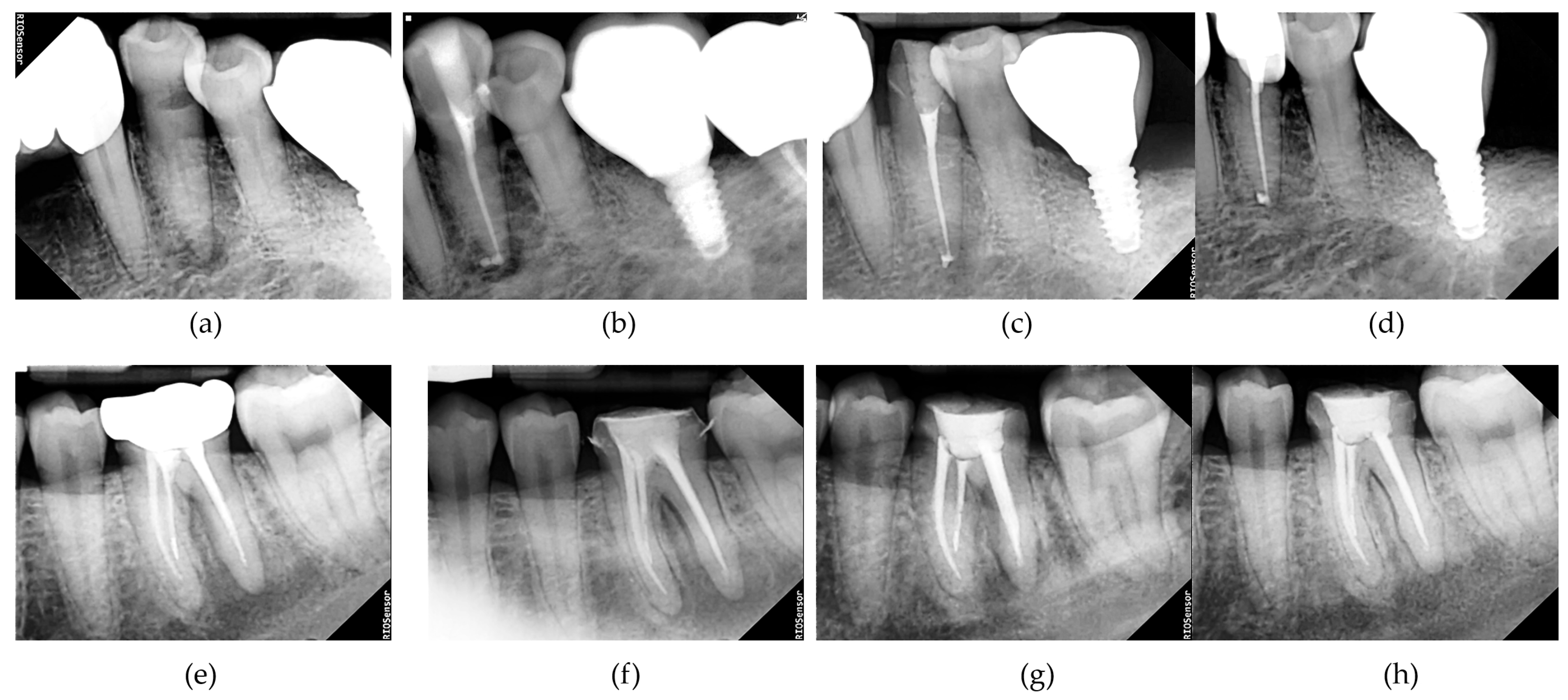
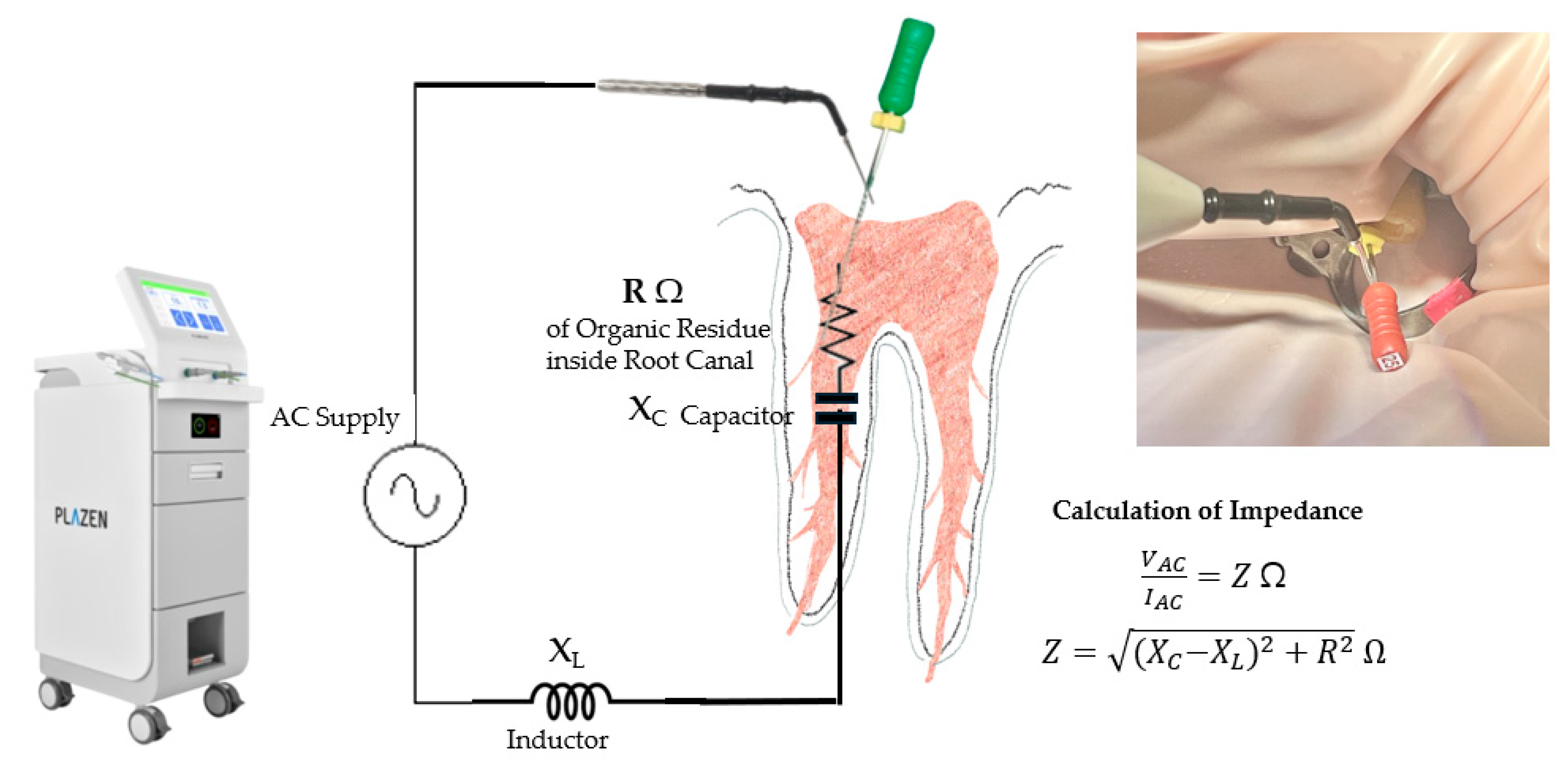
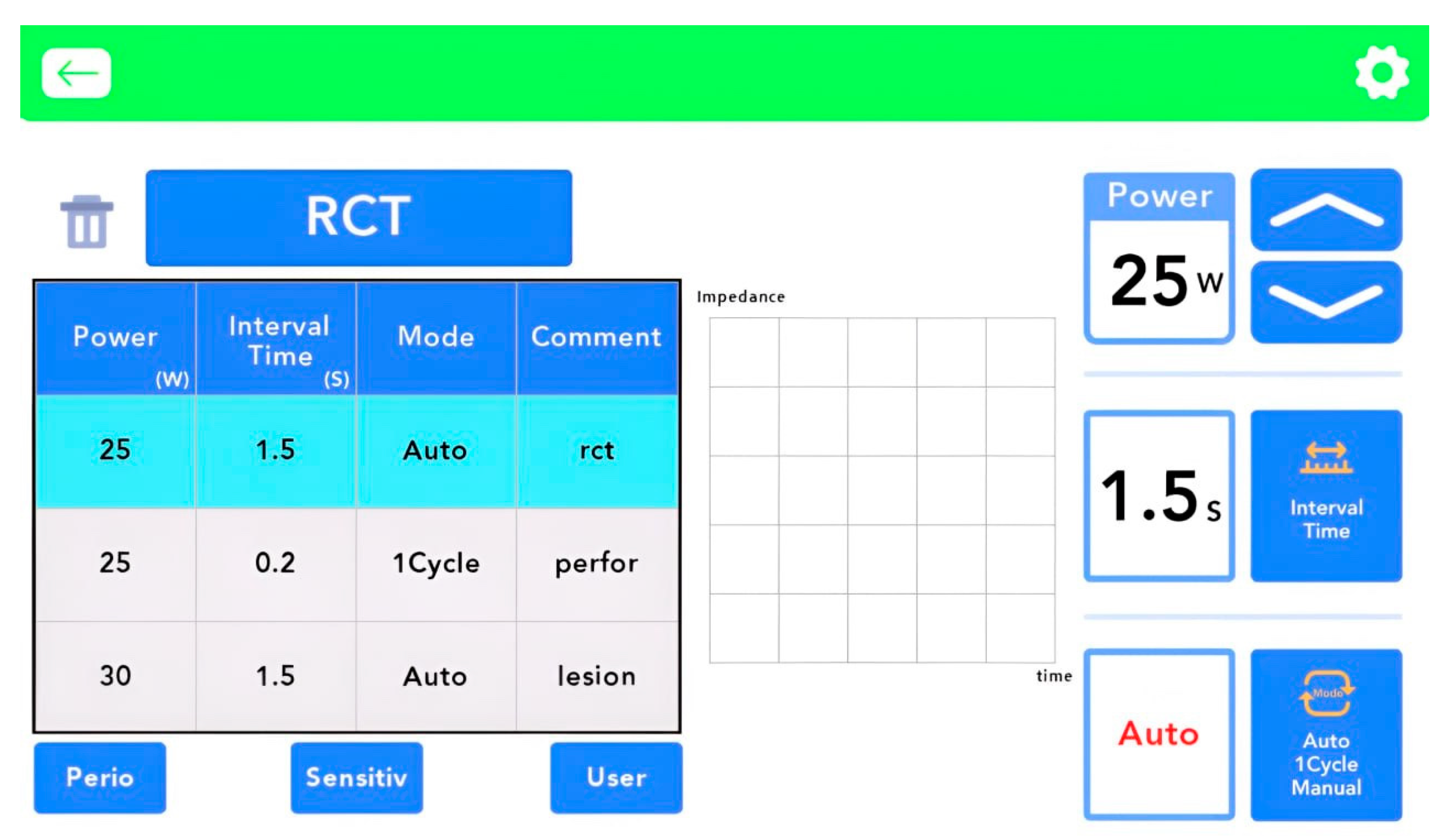
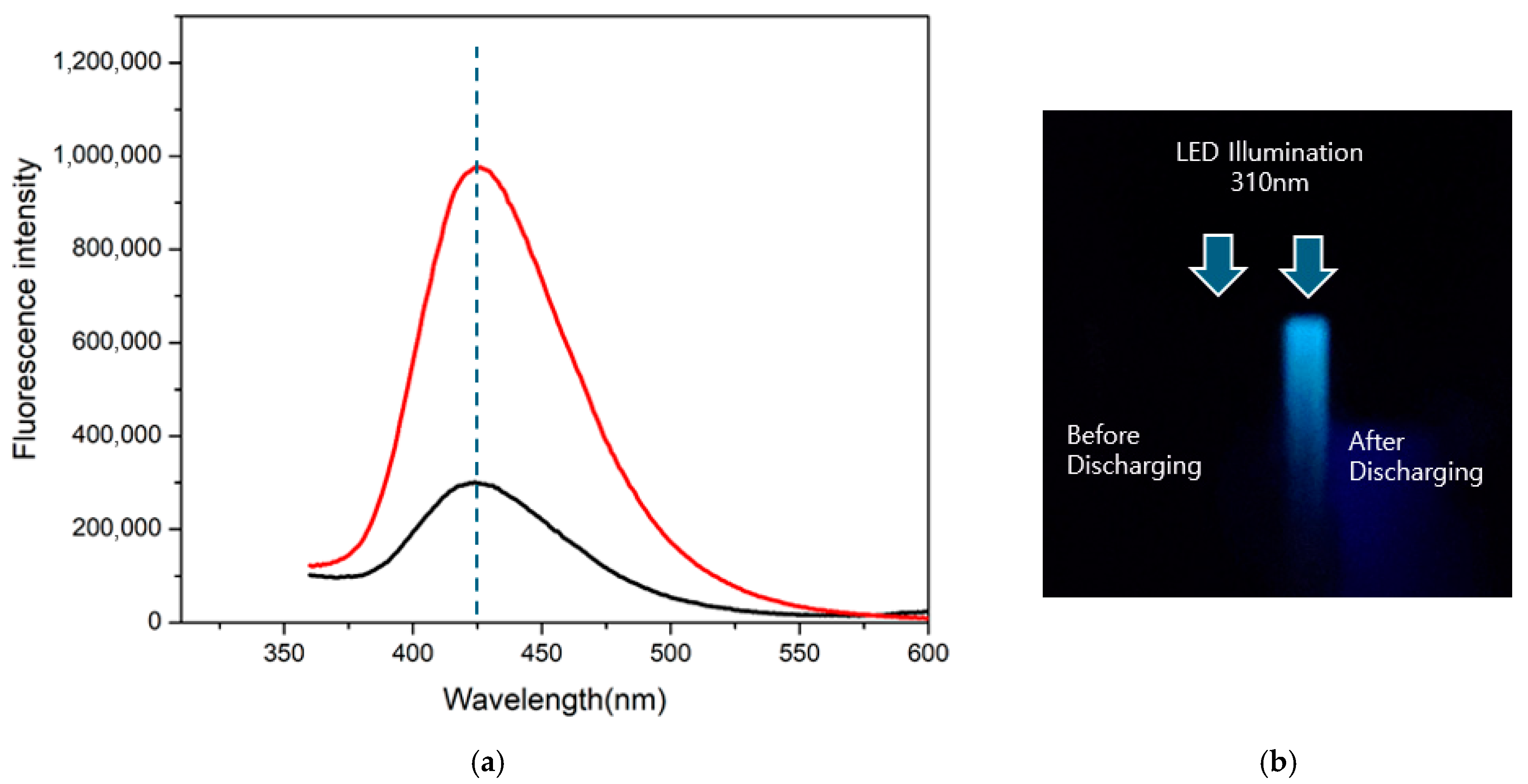
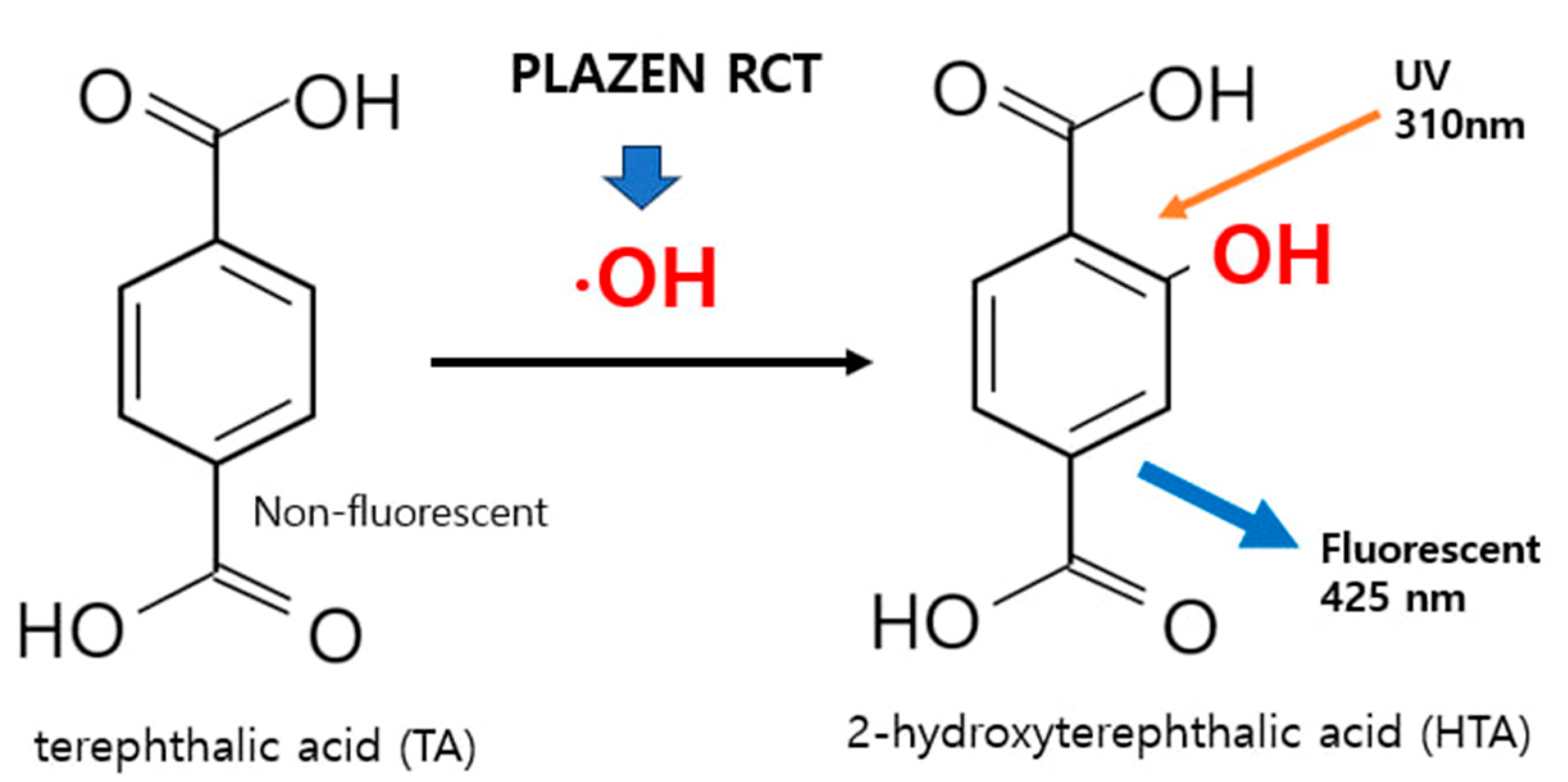
| Group | Men, n (%) | Women, n (%) | Mean Age in Years (mean ± SD) | Single Canal, n (%) | Multiple Canals, n (%) | Maxilla, n (%) | Mandible, n (%) |
|---|---|---|---|---|---|---|---|
| UDP (n = 14) | 7 (50) | 7 (50) | 50.00 ± 15.48 | 7 (50) | 7 (50) | 8 (57) | 6 (43) |
| NaOCl (n = 14) | 3 (21) | 11 (79) | 57.93 ± 14.43 | 3 (21) | 11 (79) | 8 (57) | 6 (43) |
| Total (n = 28) | 10 (36) | 18 (64) | 53.96 ± 15.23 | 10 (36) | 18 (64) | 16 (57) | 12 (43) |
| Group | Chi-Square (χ2) | p Value |
|---|---|---|
| UDP | 11.28 | 0.010 |
| NaOCl | 10.17 | 0.017 |
| Time | Mean VAS Score Mean ± SD | p Value | |
|---|---|---|---|
| UDP | NaOCl | ||
| Preoperative | 1.57 ± 1.99 | 2.14 ± 2.48 | 0.603 |
| Postoperative | 0.86 ± 1.66 | 1.14 ± 1.75 | 0.804 |
| 2 months | 0.07 ± 0.27 | 0.36 ± 0.63 | 0.329 |
| 4 months | 0.07 ± 0.27 | 0.14 ± 0.54 | 0.000 |
| Time | Mean PAI Score Mean ± SD | p Value | |
|---|---|---|---|
| UDP | NaOCl | ||
| Preoperative | 2.46 ± 1.24 | 2.16 ± 1.08 | 0.603 |
| Canal Filling | 2.45 ± 1.24 | 1.98 ± 0.77 | 0.376 |
| 2 months | 1.96 ± 0.88 | 1.71 ± 0.71 | 0.511 |
| 4 months | 1.66 ± 0.79 | 1.43 ± 0.62 | 0.401 |
| Time | Clinical Success Rates (%, n) | p Value | |
|---|---|---|---|
| UDP | NaOCl | ||
| CF | 50.0 (7) | 78.6 (11) | 0.236 |
| 2 months | 57.1 (8) | 78.6 (11) | 0.420 |
| 4 months | 71.4 (10) | 92.9 (13) | 0.326 |
| Group | Healed, n (%) | Not Healed, n (%) | Improved (Decrease PAI Score) |
|---|---|---|---|
| UDP (n = 14) | 10 (71.4) | 4 (28.6) | 71.4% (n = 10) |
| NaOCl (n = 14) | 13 (92.9) | 1 (7.1) | 78.6% (n = 11) |
| Total (n = 28) | 23 (82.1) | 5 (17.9) | 75.0% (n = 21) |
Disclaimer/Publisher’s Note: The statements, opinions and data contained in all publications are solely those of the individual author(s) and contributor(s) and not of MDPI and/or the editor(s). MDPI and/or the editor(s) disclaim responsibility for any injury to people or property resulting from any ideas, methods, instructions or products referred to in the content. |
© 2025 by the authors. Licensee MDPI, Basel, Switzerland. This article is an open access article distributed under the terms and conditions of the Creative Commons Attribution (CC BY) license (https://creativecommons.org/licenses/by/4.0/).
Share and Cite
Lyu, J.-H.; Kim, Y.-H.; Chung, H.-S.; Park, S.-Y.; Yi, S.-M.; Byun, S.-H.; On, S.-W.; Lee, J.-S.; Yang, B.-E. Clinical Evaluation of Underwater Discharge Plasma as a Root Canal Irrigant: A Randomized Pilot Study on Efficacy and Safety. Biomedicines 2025, 13, 2343. https://doi.org/10.3390/biomedicines13102343
Lyu J-H, Kim Y-H, Chung H-S, Park S-Y, Yi S-M, Byun S-H, On S-W, Lee J-S, Yang B-E. Clinical Evaluation of Underwater Discharge Plasma as a Root Canal Irrigant: A Randomized Pilot Study on Efficacy and Safety. Biomedicines. 2025; 13(10):2343. https://doi.org/10.3390/biomedicines13102343
Chicago/Turabian StyleLyu, Jeong-Hyo, Young-Hee Kim, Hyun-Sook Chung, Sang-Yoon Park, Sang-Min Yi, Soo-Hwan Byun, Sung-Woon On, Jae-Seo Lee, and Byoung-Eun Yang. 2025. "Clinical Evaluation of Underwater Discharge Plasma as a Root Canal Irrigant: A Randomized Pilot Study on Efficacy and Safety" Biomedicines 13, no. 10: 2343. https://doi.org/10.3390/biomedicines13102343
APA StyleLyu, J.-H., Kim, Y.-H., Chung, H.-S., Park, S.-Y., Yi, S.-M., Byun, S.-H., On, S.-W., Lee, J.-S., & Yang, B.-E. (2025). Clinical Evaluation of Underwater Discharge Plasma as a Root Canal Irrigant: A Randomized Pilot Study on Efficacy and Safety. Biomedicines, 13(10), 2343. https://doi.org/10.3390/biomedicines13102343








